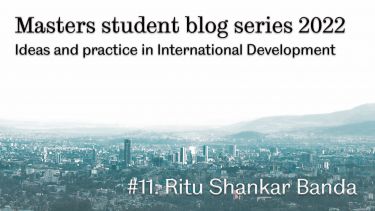By Ritu Shankar Banda.
Ritu Shankar is a student on the MSc Environmental Change and International Development. Connect with her on LinkedIn.
In 16th century Europe, many moral debates were organized to discuss the rights and treatment of indigenous people of colonies and one such important debate was the ‘Valladolid debate’ of 1550. The debate allows us to understand western perceptions of the ‘other’ and how evangelical aspirations of the colonial project were used to justify such perceptions. The debate centred around questions such as: can native Indians can be categorized as ‘non-human’ because they engaged in religious practices like human sacrifice? Could they be considered equals? Some of the notable remarks made at the end were: a native was an ‘object’ in the eyes of God as opposed to a European being a ‘subject’. He is not a part of the land but of landscape, equivalent to a tree, hill or animal (Todorov,1984).
Fig 1, Source: Wikimedia commons, Library of Congress (2005). Creative commons license. Description: The Pride of Columbus.
This lithograph (Fig1) of 1866 depicts a native Indian as a hybrid human (half human, half animal) smoking tobacco which was considered barbaric by European conquers. Columbus is portrayed as ‘Demeter’, the greek god of harvest; Saviour of native Indians. This picture aptly describes what constitutes a ‘’Valladolidian non-human’’.
Western perception of ‘other’ is the opposite of ‘self’. The other only exists as a counter entity to understand the self better. Therefore, the identity of the other is derived from judgment by self. So while the self becomes the subject, the other becomes an object (Levinas,1969). When the other and its complex culture is difficult to understand, it becomes a source of discomfort and thus hatred for the self which forms the basis for racial discrimination in most countries today. An infamous example can perhaps be cited from the United States of America.
Soon after his inauguration, President Donald Trump signed several executive orders in 2017 that sought to ban Muslims from entering the country. His campaign promises included a total ‘’Muslim ban’’ and the EOs subsequently legitimized popular anti-Muslim discourse that reproduced misconceptions and deeply gendered stereotypes about the community. A reference to honour killing was used in the first EO which appropriated violence against Muslim women by men to justify the ban on the entire community and their collective punishment. This brand of ‘’imperial feminism’’ again echoes the idea of western imperialists as saviours, undertaking imperial projects to rescue other communities from barbarism (Gokariksel, 2017).
Buen Vivir is a post-neo-liberal concept of alternative development that originated among indigenous communities of Latin America in the 1990s. Sumak kawsay is the Ecuadorian concept of Buen Vivir. It refers to ‘fulness of life’, living in harmony with different communities and with nature. It seeks to dissolve human-nature dualism (Gudynas,2011). It recognizes the importance of accepting other communities as an equal. The identity of self is derived from the community and the identity of the community is in turn derived from nature. Because of this, it takes a complete U-turn from the western perception of self because the other is no longer a reflection of self but becomes ‘another self’ and nature becomes a subject of society (Gudynas,2011). Therefore, through Sumak Kawsay, the ‘’Valladolidian non-human’’ turns into a ‘’Buen Vivirian human’’ because his identity is accepted by society as equal.
Fig 2, Source: Flickr. Creator: Franziska Surber (2012). Creative commons license. Description: Buen Vivir
This Buen Vivir poster (Fig2) contains a symbol of ‘Flower of Life’ which stands for life originating from a single source surrounding the circle. Here it is ‘Nature’. The poster is captioned as ‘Culture of good living is living in freedom’.
Modern concepts of equality and human rights promulgated by neo-liberal democratic institutions are exclusively based upon maintaining peace and order in society rather than practising socio-cultural acceptance of the identity of other; an African or Asian. Restructuring policy components to incorporate ideas of Buen Vivir, abandoning silo thinking and administration, disassociating with colonial policy practice and encouraging subaltern knowledge production could help us to tackle racism, often intertwined in intersectional inequalities (Radcliffe,2018).
References
- Gudynas, E. (2011). Buen Vivir: Today’s tomorrow. Development 54, pp.441-447. Available from: https://link.springer.com/article/10.1057/dev.2011.86
- Levinas, E. (1991). Totality and Infinity: An Essay on Exteriority. Martinus Nijhoff Philosophy Texts, vol 1. Springer, Dordrecht. Available from: https://link.springer.com/book/10.1007/978-94-009-9342-6
- Todorov, T. (1984). The Conquest of America: The Question of the Other. New York: Harper Perennial [internet archive], Pp.34-50. Available from: https://archive.org/details/conquestofameric0000unse/page/n9/mode/2up
- Radcliffe, S.A. (2018). Tackling Complex Inequalities and Ecuador’s Buen Vivir: Leaving No-one Behind and Equality in Diversity. Bulletin of Latin American Research, Vol. 37, No. 4, pp.417-433. Available from: https://onlinelibrary.wiley.com/doi/pdf/10.1111/blar.12706?casa_token=BuIi8nR46f4AAAAA:-AMrwHK8F8p7OojCDtRHblhRAEZCxyxR3kSLueEgYJUEo7crokG8LzNk9TsvLm2PKWEVrOgYer3PYU8
- Gökarıksel, B. (2017). The body politics of Trump’s “Muslim Ban”. Journal of Middle East Women's Studies, 13(3), 469-471. Available from: https://doi.org/10.1215/15525864-4179133

